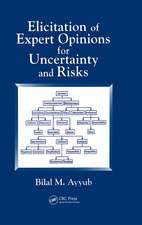Simulation Modeling with Simio
Autor Jeffrey Allen Joines, Steven Dean Robertsen Limba Engleză Paperback
This workbook features a participatory style of learning. You don't sit and read the book without a computer loaded with SIMIO. We expect your active participation in using SIMIO as you turn the pages. We try to carry on a conversation with you. Our belief is that simulation is not a spectator sport.
This edition of the workbook has an evolved structure based on use and experience. More emphasis is placed on "why" modeling choices are made, to supplement the "how" in using SIMIO in simulation. In Chapter 1, we present fundamental simulation concepts, independent of SIMIO which can be skipped for those who already understand these fundamentals. In Chapters 2 through 6, concentrates of the use of the Standard Library Objects in SIMIO. You can do a lot of simulation modeling without resorting to more complex concepts. A key part of those chapters is learning to identify/separate the data in a model from the model structure. Chapter 7 introduces the fundamental topic of "processes," which we frequently employ in the following chapters. Chapters 8 and 9 concentrate on the important topics of flow and capacity. Chapter 10 introduces optimization in the context of supply chain modeling. Chapter 11 presents the influence of bias and variability on terminating and steady-state simulation. Chapter 12 introduces SIMIO materials handling features. Chapter 13 extends the use of resources while Chapters 14 and 15 describes the use of workers including the detailed services provided by task sequences and their animation. Chapter 16 details the simulation of call centers with reneging, balking, and cost optimization. Chapters 17 through 20 presents object-oriented simulation capabilities in SIMIO. Chapter 17 builds a model out of an existing model (we call it sub-modeling). Chapter 18 describes the anatomy of an existing SIMIO and in Chapter 19 we build a new object by "sub-classing" an existing object. In Chapter 20 a new object is designed and built from a base SIMIO object and its creation is contrasted with standard SIMIO object. Chapter 21 presents some of the continuous modeling features in SIMIO. Chapters 22 and 23 demonstrates the power of object-oriented simulation in the modeling supply chains and process planning respectively. We include an appendix on input modeling, although SIMIO does not provide software.
The book is designed to be read from chapter to chapter, although it is possible to pick out certain concepts and topics. Some redundancy is helpful in learning. By the time you have finished this book you should be well-prepared to build models in SIMIO and to understand the virtues of different modeling approaches.
Like SIMIO itself, this workbook has been designed for a variety of student, teacher, and practitioner audiences. For example, if you are interested in manufacturing, you will want to be sure to study data-based modeling in Chapter 5, assemply and packaging in Chapter 6, the workstation in Chapter 9, and material handling in Chapter 12. If you are interested in logistics, don't miss modeling of distances in Chapter 3, flow and capacity in Chapter 8, inventories and supply chains in Chapter 10, and free space travel in Chapter12. If you are interested in healthcare, be sure to review scheduled arrivals in Chapter 8, resource decision making in Chapter 13, mobile workers in Chapter 14, and animated people and task sequences in Chapter 15. If object-oreinted simulation is your interest, make sure to study Chapters 17 through 20, which describes how SIMIO provides composition and inheritance to create objects. Manufacting examples and examples from the service sector are used throughout. Also we pay some attention to input modeling (including input sensitivity) and output analysis (including confidence intervals and optimization). This workbook provides comprehensive and in-depth discussion of simulation modeling with SIMIO.
Preț: 331.62 lei
Nou
63.46€ • 66.01$ • 52.39£
Carte disponibilă
Livrare economică 22 martie-05 aprilie
Specificații
ISBN-10: 1519333935
Pagini: 432
Dimensiuni: 216 x 280 x 22 mm
Greutate: 0.99 kg
Editura: CreateSpace Independent Publishing Platform














